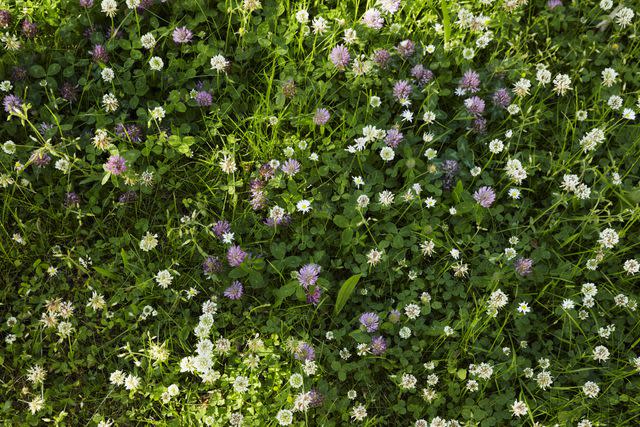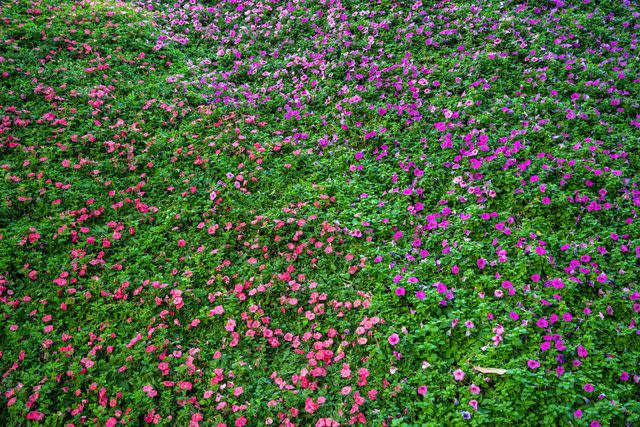How to Grow a Tapestry Lawn—the Landscaping Trend That Turns Your Yard Into a Living Masterpiece
Also called a meadow lawn, this landscaping technique requires little to no maintenance to thrive.
:max_bytes(150000):strip_icc():format(jpeg)/ms-tapestry-lawn-getty-4f1bfa99ae09480c85d22cb7034f1d1d.jpg)
undefined undefined
A tapestry lawn (also known as a matrix garden, meadow lawn, prairie lawn, or patchwork lawn) is a low-maintenance alternative to traditional grass that requires no fertilizer, infrequent mowing, and little supplemental irrigation. It involves removing your existing turf and replacing it with a mix of native plants and flowers of varying heights, sizes, and textures for both aesthetic and ecological benefits. If you're interested in converting your turf grass to a tapestry lawn, we're sharing everything you need to know about this landscaping technique.
Meet the Expert
Carrie Spoonemore, co-creator of Park Seed's From Seed to Spoon app
Benjamin Vogt, owner of Monarch Gardens LLC
What Is a Tapestry Lawn?
A tapestry lawn is a type of lawn that uses low-growing plants with colorful foliage or flowers in place of traditional turf. "Instead of a traditional lawn made of a single type of grass, a tapestry lawn creates a diverse and visually appealing landscape," says Carrie Spoonemore, co-creator of Park Seed's From Seed to Spoon app. "The term 'tapestry' refers to the idea of weaving together different elements to create a rich pattern. It often incorporates grasses, ground covers, herbs, and low-growing flowering plants."
While most homeowners opt for low landscapes, a tapestry lawn can vary in height. Low-lying options are around 6 to 10 inches, but your site can be scaled up to 48 inches depending on your turf and goals. "In general, such a landscape will include plants that move about, fill gaps, and generally show a new arrangement season to season and year to year—just as they would in wilder nature," says Benjamin Vogt, the owner of Monarch Gardens LLC.
Related: Rebranding the Great American Lawn for the 21st Century
Benefits of a Tapestry Lawn
Growing a tapestry lawn in lieu of traditional turf has many benefits. It's easier on you and great for local wildlife.
Low Mow
Unlike traditional turf, tapestry lawns require less mowing because they incorporate slower-growing plants and ground covers that don’t need frequent trimming, says Spoonemore.
Low Water
Once established, many of the plants chosen for tapestry lawns are drought-tolerant, reducing the need for frequent watering, says Spoonemore. These plants can typically survive and thrive off the land's natural rainfall.
Eco-Friendly
Tapestry lawns typically feature a variety of plant species that attract pollinators, birds, and other wildlife to the garden. "This diversity contributes to a healthier ecosystem and reduces the reliance on chemical fertilizers and pesticides," says Spoonemore.
Shade-Tolerant
Some plants used in tapestry lawns are shade-tolerant, meaning they can thrive in areas with limited sunlight. "This makes tapestry lawns suitable for a variety of garden conditions, including shady spots where traditional grass may struggle to grow," says Spoonemore.

The Best Plants to Use
The plants you grow in your tapestry lawn should be native to your area, low-growing, drought-tolerant, and adaptable to various soil types and light conditions. "They should also be able to coexist with other plants without becoming overly aggressive or invasive," says Spoonemore.
Some qualities to look for in plants for a tapestry lawn include a spreading or clumping habit, attractive foliage, long blooming periods, and the ability to withstand occasional foot traffic, she says. Some plants that fit the bill include:
Creeping Thyme
Irish Moss
Sedum
Mini Ornamental Mint
Japanese Spurge
Moonshadow Euonymus
Angelina Stonecrop
How to Plant a Tapestry Lawn
Once you've selected your plants, you can start making your tapestry lawn by following these steps, says Spoonemore.
Mark the boundaries of the area where you want to establish the tapestry lawn.
Use a sod cutter, shovel, or mechanical turf remover to remove the existing grass and weeds from the designated area.
Amend the soil as needed to improve its texture, fertility, and drainage. This may involve adding organic matter such as compost, aged manure, or peat moss.
Use a garden fork or tiller to loosen the soil to a depth of about 6 to 8 inches. Remove any rocks, debris, weeds, or large clumps of soil.
Rake the soil smooth and level.
Plant your selected plants according to their recommended spacing and depth. Arrange the plants so that you're mixing different species and varieties to create a diverse tapestry effect.
After planting, thoroughly water the area to settle the soil and ensure good root-to-soil contact.
Monitor the soil’s moisture level regularly. Keep the soil evenly moist but not waterlogged.

How to Care for and Maintain a Tapestry Lawn
Generally, you won't need to perform very much monthly maintenance on your tapestry lawn, but it will require some attention throughout the year.
Water
Once your plants are established, you won't need to water them too often. "Water deeply and infrequently to encourage deep root growth and drought tolerance," says Spoonemore. "Water early in the morning, monitor soil regularly, and adjust as needed."
Mowing
How often you mow depends on the plants used in the tapestry lawn. Generally, you should avoid mowing too frequently, as some plants may benefit from being allowed to grow taller before being trimmed back, says Spoonemore. You can mow to maintain a neat appearance, as needed.
Sunlight
Ensure your tapestry lawn receives the appropriate amount of sunlight for the plants chosen. "Monitor the amount of sunlight reaching the lawn throughout the day and consider pruning nearby trees or shrubs to optimize light exposure if necessary," says Spoonemore.
Soil
Test your soil periodically to assess pH and nutrient levels and adjust accordingly. To maintain soil fertility, you can amend your soil with organic matter such as compost or aged manure.
Fertilizer
Commercial fertilizer isn't necessary, but you can use organic fertilizers sparingly. Consider top-dressing with compost or organic mulch annually to provide a slow-release source of nutrients and improve soil structure, says Spoonemore.
Common Problems When Growing a Tapestry Lawn
While there are certainly perks to this low-maintenance approach to lawn care, one major downside of a tapestry lawn is that it doesn't do well in areas with heavy foot traffic, which can cause soil compaction. Other issues include susceptibility to diseases and pests, weed invasion, uneven growth among plant species, and potential nutrient deficiencies over time.
To maintain lawn health, be vigilant about weed management and regularly monitor for pests and diseases. "Additionally, soil aeration and replenishing organic matter can help mitigate soil compaction and nutrient deficiencies," says Spoonemore. "Selecting regionally appropriate plant species and implementing water-wise gardening practices can also help withstand environmental stressors."
Read the original article on Martha Stewart.

